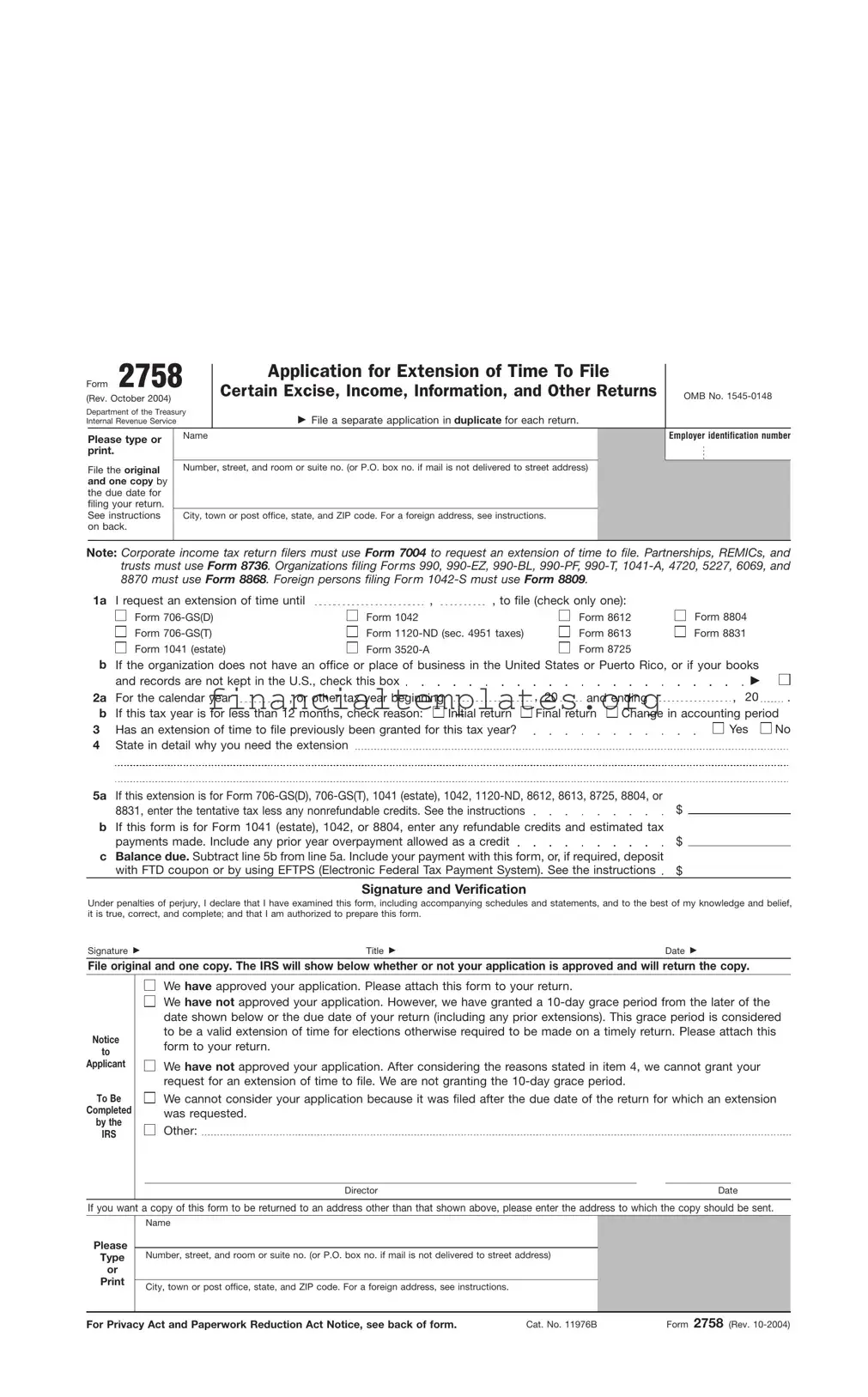The Form 7004, Application for Automatic Extension of Time To File Certain Business Income Tax, Information, and Other Returns, parallels the IRS Form 2758 in its primary function—to request more time for filing tax-related documents. While Form 2758 caters to a specific subset of taxes, including certain excise, income, information, and other returns, Form 7004 is directed towards businesses requiring additional time to file their income tax and information returns. Both forms necessitate that the filer submits the request by the original due date of the return to avoid late filing penalties, illustrating the core similarity in their procedural use.
Form 8736, Application for Automatic Extension of Time To File U.S. Return for Partnership, REMIC, or for Certain Trusts, also shares commonality with Form 2758 by serving as a mechanism to request extra time for filing taxes. Specifically targeting partnerships, real estate mortgage investment conduits (REMICs), and certain trusts, Form 8736 accommodates a different taxpayer subgroup compared to Form 2758. Despite this distinction in audience, both forms offer a relief pathway for filers unable to meet the original filing deadline, underlining their similarity in purpose and functionality.
Organizations seeking more time to file forms such as 990, 990-EZ, and others can utilize Form 8868, Application for Extension of Time To File an Exempt Organization Return. Much like Form 2758, Form 8868 assists taxpayers in requesting additional filing time, albeit tailored for exempt organizations. Both documents are crucial for compliant tax practices, allowing varied entities—the former extending to a broad range of taxpayers, and the latter to tax-exempt organizations—to manage and fulfill their filing obligations within an extended timeframe.
Form 8809, Application for Extension of Time To File Information Returns, resembles Form 2758 in that it applies to a broad range of information returns, such as Form 1042-S for foreign persons. Its main purpose is to grant filers a reprieve from the original due date, a hallmark feature shared with Form 2758. Both forms cater to distinct tax document requirements, yet their similarity lies in the fundamental service they provide—extending the filing deadline to ensure thorough and accurate tax reporting.
Form 4868, Application for Automatic Extension of Time To File U.S. Individual Income Tax Return, though aimed at individual filers, shares a common goal with IRS Form 2758: to provide taxpayers additional time to file their returns. Despite serving different tax filer categories, with Form 4868 specifically designed for individual income tax returns, both forms are instrumental in alleviating the pressure of the filing deadline, emphasizing their role in taxpayer assistance and compliance.
Form 2350, Application for Extension of Time To File U.S. Income Tax Return, particularly serves U.S. citizens and resident aliens abroad who need more time to qualify for certain tax benefits. This form's specialized focus contrasts with the broader application range of Form 2758, but parallels it in providing a means to extend filing deadlines under specific criteria, thereby reflecting a shared purpose in facilitating tax compliance under extenuating circumstances.
Form 5558, Application for Extension of Time To File Certain Employee Plan Returns, offers a targeted approach to extending deadlines for filing pension and benefit plan returns. While this form caters to a niche aspect of tax obligations, its core functionality aligns with that of Form 2758—both enable an extension for filers under particular classifications, underscoring their similar utility in tax administration despite differing scopes.
Form 7004, distinct from its aforementioned use for businesses, also supports specific requests for extension related to foreign trusts by filing Form 3520-A, highlighting the versatility and wide applicability of extension applications across various tax responsibilities. This aspect of Form 7004 demonstrates a broader parallel with Form 2758 concerning the wide-ranging impact of extension applications in tax practice, embodying the critical role of these documents in ensuring comprehensive compliance and reporting.
Finally, Form 8992, U.S. Shareholder Calculation of Global Intangible Low-Taxed Income (GILTI), does not directly offer an extension but necessitates accurate and timely filing influenced by the extensions granted through forms like 2758. While not an extension form, the meticulous filing requirements and the potential need for additional time to gather and calculate international income underscore the indirect relationship between specific tax obligations and the general utility of filing extensions as facilitated by forms like IRS 2758.
In summary, while each of these documents serves different segments of the taxpaying public and pertains to varied types of tax obligations, the underlying similarity among them and Form 2758 is their provision for additional time to file. This critical function ensures taxpayers can meet their filing obligations accurately and comprehensively, reflecting the overarching goal of the tax filing extension system.


